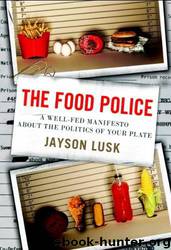The Food Police: A Well-Fed Manifesto About the Politics of Your Plate by Jayson Lusk

Author:Jayson Lusk
Language: eng
Format: mobi
Tags: Technology & Engineering, Social Science, Food Science, Agriculture & Food
ISBN: 9780307987044
Publisher: Crown Forum
Published: 2013-04-16T07:00:00+00:00
The fact that the food police can’t quite figure out the real effects of farm subsidies hasn’t in the least hindered their desire to remake farm policy. The food elite, not understanding the present, believe they have a crystal ball into the future.
At the forefront of the policy agenda of the food elite is a desire not to cut farm subsidies but to expand and reallocate them toward their favored foods. Writing in the New York Times, Mark Bittman proposes “support designed to encourage a resurgence of small- and medium-size farms producing not corn syrup and animal-feed but food we can touch, see, buy and eat—like apples and carrots—while diminishing handouts to agribusiness and its political cronies.”34 It is a mystery as to why Bittman supposes the agribusinesses and political cronies supposedly benefiting from subsidies to corn and rice wouldn’t also figure out how to profit from federal subsidies to apple and carrot growers. So goes the apparent belief that the favored veggies are morally good and incorruptible while their sleazy wheat and soybean cousins have gone over to the dark side.
If we started subsidizing spinach, artichokes, and arugula, sure, we’d get more of them. But then what? Which agricultural crops do you suppose are the biggest users of water, fertilizers, insecticides, and herbicides? It’s not necessarily those evil crops the government currently subsidizes.
If we began subsidizing the crops favored by the food elite, we’d likely see massive increases in chemical use. On average, wheat and soybean farmers use about 0.02 pounds of active insecticide per acre planted; corn farmers use more, at 0.13 pounds per acre. A farmer who plants the same acreage with okra, cabbage, cauliflower, tomatoes, or melons uses about 62 times the pesticide as a wheat or soybean farmer and about 10 times the pesticides as a corn farmer. Lettuce and strawberry farmers use more than 100 times the pesticides as wheat and soybean farmers on a per-acre basis, and don’t even mention the citrus growers, who use more than 2,500 times the pesticides!
It isn’t just pesticides; it’s other chemicals, too. Topping the list of herbicide use on a per-acre basis are crops such as sugarcane, beets, rice, citrus, onions, cranberries, parsley, and asparagus. Cherries, apples, strawberries, tomatoes, and grapes use more than 750 times the amount of fungicides per acre planted as wheat, soybeans, and corn!35
Chemicals are just one input used to produce food. How about other resources? Although some vegetables, such as beans, cabbage, and peas, are relatively efficient users of water, it takes more water to produce some types of fruits and vegetables than crops such as soybeans and corn. For example, compared with soybeans, it takes about 4 percent more water to grow tomatoes, 30 percent more water to grow peppers, 39 percent more water to grow sunflowers, 83 percent more water to grow citrus fruits, and 195 percent more water to grow bananas.36 In their myopic attempt to use government policy to try to get healthy food, the food police seem to forget all the other things that will come with it.
Download
This site does not store any files on its server. We only index and link to content provided by other sites. Please contact the content providers to delete copyright contents if any and email us, we'll remove relevant links or contents immediately.
Nutrition for Sport, Exercise, and Health by Spano Marie & Kruskall Laura & Thomas D. Travis(3715)
Nutrition for Sport, Exercise, and Health by Marie Spano & Laura Kruskall & D. Travis Thomas(3683)
The Sprouting Book by Ann Wigmore(3543)
Flavor Flours by Alice Medrich(2814)
Superfood Smoothie Bowls: Delicious, Satisfying, Protein-Packed Blends that Boost Energy and Burn Fat by Chace Daniella(2387)
Memory Rescue by Daniel G. Amen(2377)
Dirty Genes by Ben Lynch(2272)
The Bad Food Bible by Aaron Carroll(2235)
Genius Foods by Max Lugavere(2179)
The Poisoner's Handbook by Deborah Blum(2091)
Good Calories, Bad Calories by Gary Taubes(2072)
The Main Street Vegan Academy Cookbook by Victoria Moran(2033)
The I Quit Sugar Cookbook by Sarah Wilson(2001)
Core Performance Essentials by Mark Verstegen(1981)
Memory Rescue: Supercharge Your Brain, Reverse Memory Loss, and Remember What Matters Most by Amen Dr. Daniel G(1948)
Big Girls Do It Stronger by Jasinda Wilder(1899)
Android App Development by Franceschi Hervé J.;(1819)
Sugar Crush by Dr. Richard Jacoby(1770)
Dr. Colbert's Keto Zone Diet by Don Colbert(1629)
